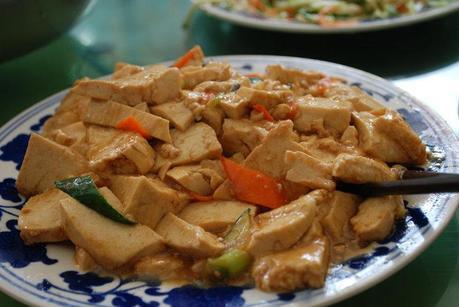 It is a common theme on this blog for me to talk about how hard of time I had finding food suitable to my tastes while in China. Between days of being sick or being in a travel rut after 60 days of continually moving I would be lying if I said that I didn't hit McDonald's a few (dozen) times to cope. But while I like to play up these stories in my articles I am really doing a disservice to China by not taking a minute to look at the other side of the spectrum. There is actually some good food in China. Really good food. In fact, a few of the dishes I had in China were far better than anything I could have imagined, and it is time I shared them all with you. Prepare to drool, because today we will only be talking about the good foods I had while spending a month in China.
It is a common theme on this blog for me to talk about how hard of time I had finding food suitable to my tastes while in China. Between days of being sick or being in a travel rut after 60 days of continually moving I would be lying if I said that I didn't hit McDonald's a few (dozen) times to cope. But while I like to play up these stories in my articles I am really doing a disservice to China by not taking a minute to look at the other side of the spectrum. There is actually some good food in China. Really good food. In fact, a few of the dishes I had in China were far better than anything I could have imagined, and it is time I shared them all with you. Prepare to drool, because today we will only be talking about the good foods I had while spending a month in China. Jianbing (Beijing Style Crepe)
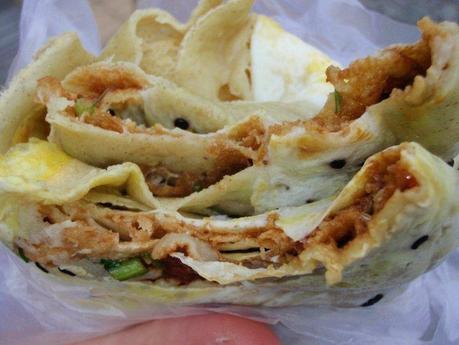
Imagine this: a wheat flour crepe topped with scallions, egg, baocui (crispy wafer), and spice pastes. What more can you truly ask for in a combination sweet and savory crepe? The answer to that is, of course, nothing.
I discovered Jianbing almost by accident on my last day when some friends in my hostel recommended a great street food just around the corner from our Beijing accommodation. Skeptical, after already feeling under the weather for a few days, I relented and tried it with amazing results. If one food could turn around an entire opinion on a country I would have to say that Jianbing did that for me (or was it the scorpion at Wangfujing Street the night before?). In any case, the half-breakfast half-lunch crepe is one dish that I will talk about until the end of time and is one you should not miss while in Beijing.
Szechuan Hot Pot
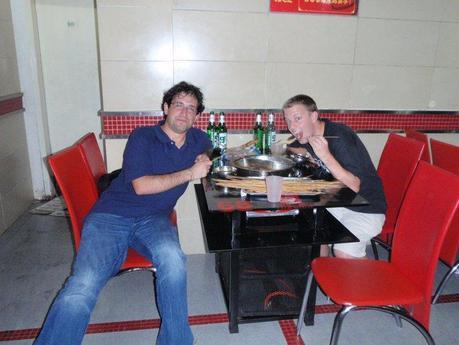
Hot pot, as you can imagine, is much like our version of a savory Fondue. Hot oils are mixed with spices (typically one hot, one mild) and you and a group a friends can cook your own meats and vegetables to your hearts content. But before you head off to try out hot pot on your own the next time you are in China, keep in mind that there are multiple styles of restaurants out there that serve this dish and could drastically dictate how your meal will evolve!
The first kind of hot pot restaurant I visited operates in a style similar to our buffets at home. All of the foods are pre-skewered and laid out on a buffet stand for you to pick and cook at your leisure. At the end of the meal a waiter comes by and counts your sticks and charges you accordingly. For myself and Michael from Art of Backpacking 100+ skewers and two giant beers each ended up being around $5 per person. A great deal.
The second kind of hot pot restaurant I visited is more of a plated meal where you order set items from the menu and a waiter brings out a tray for you to enjoy. The downside to this particular style is that you can, at most, only order 2 to 3 plates per person and is a big deterrent for solo travelers like I was at the time. While the food is massive and the plates are rather affordable ($2 to $4 per plate), the variety is a bit lacking considering the cost. So if your neighborhood hot pot restaurant is of this variety, gather a bunch of friends for the best results!
When it comes down to it; however, all hot pot is delicious. Spicy broth, a few good meats and vegetables that you can cook yourself (a key for stomachs who haven't adapted yet), and other treats that are unrecognizable all make for a great dinner. So make some friends at your hostel or hotel and go out for a wild night, and eat to your heart's content!
Chengdu Snack Menu
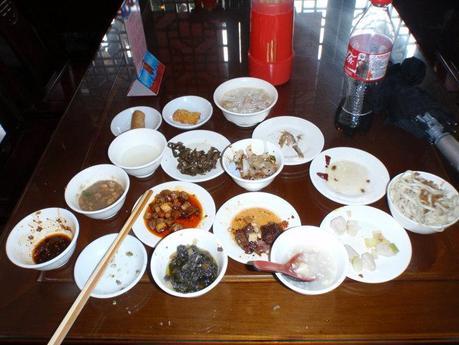
The recurring theme you are about to see is that the Szechuan city of Chengdu is a mecca for food lovers as the Chinese cooking style has clearly become my favorite. The Chengdu Snack Menu is just that, a selection of small plates of food with 1 to 2 bites that can be ordered for you to enjoy small amounts of many different treats. Most restaurants have multiple snack menus that can range from just a few plates all the way up to a 17-course tasting platter that I had to try while in Chengdu (All for under $6 no less).
The key to surviving a 17-course snack menu in Chengdu is to go in already knowing that you will not like everything, but having a willingness to try them all in the name of eating! There were plenty snacks that I didn't care for, and it would be hard for me to say what they were because they had no visible features or tastes that would be worth writing about. But for every "meh" dish there as one that is quite tasty to make up for it! My favorites included the dumpling in spicy Szechuan sauce and deep fried sardines as well as most of the vegetarian dishes and their accompanying sauces. You really can't go wrong with a $6 meal of 17 unique items, no matter how may or few you end up liking. It is the experience that counts!
Huíguōròu (Twice Cooked Pork) and Mápó Dòufǔ (Mapo Tofu)
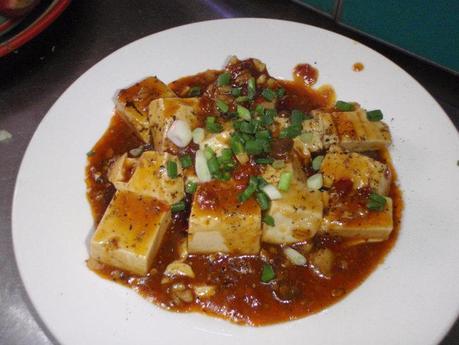
The two staples of the cooking class I took in Chengdu, Twice Cooked Pork and Mapo Tofu, are in some ways essential Szechuan dishes. This is due to the fact that they both incorporate the spicy cooking style the region is famous for without going overboard in heat that some of the other dishes featured in this list do.
Mapo Tofu is an interesting dish in that it is the first meal I've ever had that has made tofu interesting to me. This one is all about the sauce, which without it would just be a chunk of tofu (literally). The sauce is a combination of garlic, ginger, bean paste, soy sauce, cooking wine, copious sichuan pepper oil, and sichuan pepper powder. While you can make the dish as hot as you like with the last two ingredients, a mild blend produces incredibly flavorful results.
Twice Cooked Pork is one of those dishes that is made exactly as its name implies. The first cooking of a slab of pork butt comes from boiling, and the second cooking comes from pan searing smaller cut cubes. To that gets added large amounts of oil, garlic, cooking wine, ginger, bean paste, and a small bit of spices. Topped on this dish is more garlic shoots (or green onion) than one should be able to handle, and a perfect dish is delivered.
As I tried these two dishes during a cooking class, we've shared the recipe here for your enjoyment!
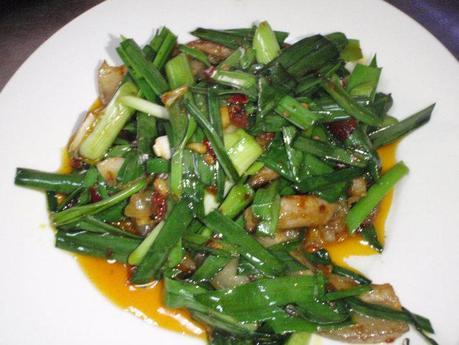
Gōngbǎo Jīdīng (Kung Pao Chicken)
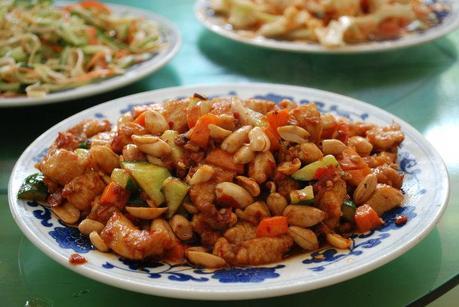
Gongbao Jiding, or to the English speakers in the audience, Kung Pao Chicken, is an interesting dish for many reasons. First of all, it is the only dish that I'm featuring in this article that you can easily find at just about every Chinese restaurant outside of the country. Second is that the iterations outside of China are actually fairly good reproductions of this iconic dish! This familiarity is one of the reasons I was drawn to eating Kung Pao Chicken so frequently while in China, even though I almost never order it while at home. So if you can imagine what Kung Pao Chicken is like here, that taste and more exists in the real Chinese equivalent.
Sweet and Sour Chicken (Seriously!)
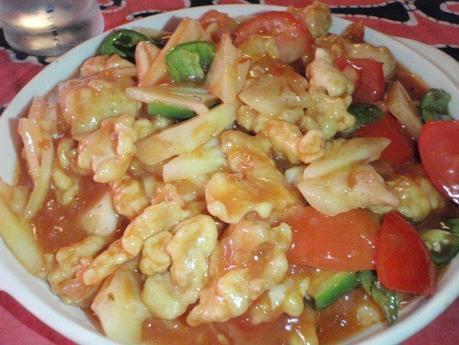
Before going to China I was under the impression that Sweet and Sour Chicken was a uniquely Western dish much like my beloved General Tso's Chicken and the fortune cookie (invented in California). While the jury is still out on whether Sweet and Sour Chicken is an actual Chinese dish, one truth remains - you can get it in China, and it is delicious.
As I began this article, I mentioned that McDonald's was my go-to meal every time I felt down. This was only the half truth as Sweet and Sour Chicken should also be classified in similar fashion. It gets a mention in this article because there is something different on the Chinese Sweet and Sour Chicken than our Red Dye #5 filled cousin at home. It is real. From good hunks of chicken to a tangy sauce that was homemade more often than not, the Chinese iteration of sweet and sour chicken is a force to be reckoned with.
Now if we could only get the Chinese restaurants at home to adapt, we'd be all set.

